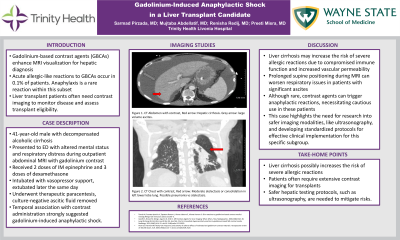Monday Poster Session
Category: Liver
P3005 - Gadolinium-Induced Anaphylactic Shock in a Liver Transplant Candidate
Monday, October 28, 2024
10:30 AM - 4:00 PM ET
Location: Exhibit Hall E

Has Audio
- SP
Sarmad Pirzada, MD
Trinity Health Livonia Hospital
Farmington Hills, MI
Presenting Author(s)
Sarmad Pirzada, MD1, Renisha Redij, MBBS1, Preeti G. Misra, MD2, Mujtaba Abdellatif, MD2
1Trinity Health Livonia Hospital, Farmington Hills, MI; 2Trinity Health Livonia Hospital, Livonia, MI
Introduction: Gadolinium-based contrast agents (GBCAs) are commonly used to enhance the quality of magnetic resonance imaging, aiding in the detailed visualization often necessary for accurate diagnosis. Acute allergic-like reactions to GBCAs are uncommon, occurring in approximately 0.1% of patients, with anaphylaxis being rare within this subset. We present an extremely rare case of a gadolinium-associated anaphylactic reaction in a patient with alcoholic cirrhosis. This prompts us to study the effects of repeated contrast exposure in transplant candidates and review the literature on alternative imaging modalities.
Case Description/Methods: A 41-year-old male with a past medical history of alcoholic cirrhosis with recurrent ascites, alcoholic neuropathy, chronic kidney disease stage II/IIIa, psoriasis, and alcohol use disorder in remission for a year, presented to the emergency room with respiratory distress and altered mental status after an MRI with gadolinium contrast. The patient was intubated and sedated with fentanyl and dexmedetomidine, initially required a norepinephrine drip for pressure support, and received IV antibiotics for spontaneous bacterial peritonitis prophylaxis. The patient was extubated the next day. Blood and urine cultures resulted negative. The temporal association with contrast administration strongly suggested gadolinium-induced anaphylactic shock.
Discussion: Liver cirrhosis may heighten the risk of severe allergic reactions due to compromised immune function and increased vascular permeability. Additionally, the supine position required for MRI could exacerbate respiratory issues in patients with significant ascites, compounding their risk of adverse outcomes. Although rare, exposure to contrast agents can cause anaphylactic reactions, highlighting the need for cautious use in this subset of patients.
Liver transplant candidates frequently undergo extensive evaluations using contrast-based imaging to monitor the progression of their liver disease and confirm their transplant eligibility. However, there is a growing need for research into safer imaging alternatives, such as ultrasound. To fully leverage the benefits of ultrasound, more protocols need to be developed and standardized to ensure its effective implementation in clinical practice.
Disclosures:
Sarmad Pirzada, MD1, Renisha Redij, MBBS1, Preeti G. Misra, MD2, Mujtaba Abdellatif, MD2. P3005 - Gadolinium-Induced Anaphylactic Shock in a Liver Transplant Candidate, ACG 2024 Annual Scientific Meeting Abstracts. Philadelphia, PA: American College of Gastroenterology.
1Trinity Health Livonia Hospital, Farmington Hills, MI; 2Trinity Health Livonia Hospital, Livonia, MI
Introduction: Gadolinium-based contrast agents (GBCAs) are commonly used to enhance the quality of magnetic resonance imaging, aiding in the detailed visualization often necessary for accurate diagnosis. Acute allergic-like reactions to GBCAs are uncommon, occurring in approximately 0.1% of patients, with anaphylaxis being rare within this subset. We present an extremely rare case of a gadolinium-associated anaphylactic reaction in a patient with alcoholic cirrhosis. This prompts us to study the effects of repeated contrast exposure in transplant candidates and review the literature on alternative imaging modalities.
Case Description/Methods: A 41-year-old male with a past medical history of alcoholic cirrhosis with recurrent ascites, alcoholic neuropathy, chronic kidney disease stage II/IIIa, psoriasis, and alcohol use disorder in remission for a year, presented to the emergency room with respiratory distress and altered mental status after an MRI with gadolinium contrast. The patient was intubated and sedated with fentanyl and dexmedetomidine, initially required a norepinephrine drip for pressure support, and received IV antibiotics for spontaneous bacterial peritonitis prophylaxis. The patient was extubated the next day. Blood and urine cultures resulted negative. The temporal association with contrast administration strongly suggested gadolinium-induced anaphylactic shock.
Discussion: Liver cirrhosis may heighten the risk of severe allergic reactions due to compromised immune function and increased vascular permeability. Additionally, the supine position required for MRI could exacerbate respiratory issues in patients with significant ascites, compounding their risk of adverse outcomes. Although rare, exposure to contrast agents can cause anaphylactic reactions, highlighting the need for cautious use in this subset of patients.
Liver transplant candidates frequently undergo extensive evaluations using contrast-based imaging to monitor the progression of their liver disease and confirm their transplant eligibility. However, there is a growing need for research into safer imaging alternatives, such as ultrasound. To fully leverage the benefits of ultrasound, more protocols need to be developed and standardized to ensure its effective implementation in clinical practice.
Disclosures:
Sarmad Pirzada indicated no relevant financial relationships.
Renisha Redij indicated no relevant financial relationships.
Preeti Misra indicated no relevant financial relationships.
Mujtaba Abdellatif indicated no relevant financial relationships.
Sarmad Pirzada, MD1, Renisha Redij, MBBS1, Preeti G. Misra, MD2, Mujtaba Abdellatif, MD2. P3005 - Gadolinium-Induced Anaphylactic Shock in a Liver Transplant Candidate, ACG 2024 Annual Scientific Meeting Abstracts. Philadelphia, PA: American College of Gastroenterology.
